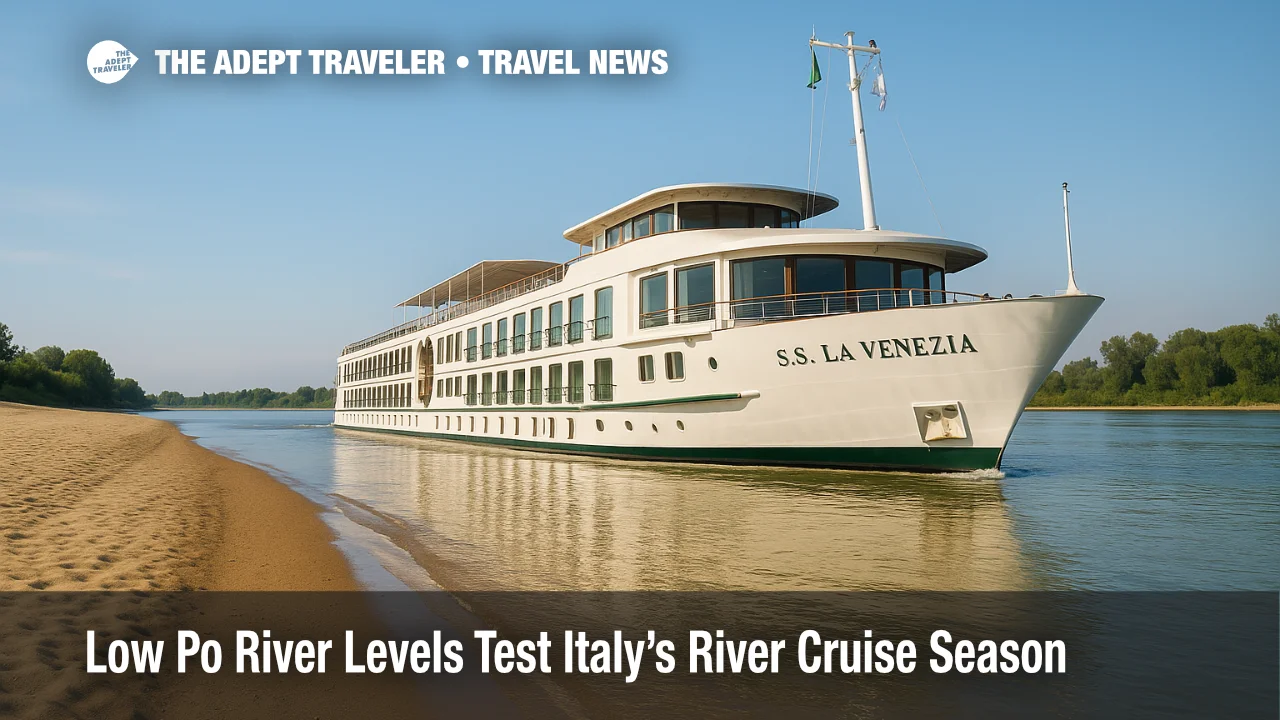Low Po River Levels Test Italy's River Cruise Season

Northern Italy's Po River has slipped well below seasonal norms, forcing cruise lines and local operators to juggle schedules, swap berths, and prepare coach transfers as the summer heat intensifies. The Po River Basin Authority's latest bulletin shows the key Pontelagoscuro gauge roughly three feet under hydrometric zero, about 35 percent less flow than the five-year July average. While no sailings have been cancelled outright, itinerary tweaks are now routine for Venice-to-Mantua programs.
Key Points
- Why it matters: Shallow water limits how far cruise vessels can penetrate inland, reshaping tours and shore time.
- Pontelagoscuro flow sits 35 percent below the five-year mean, edging toward drought-alert thresholds.
- The Po River Observatory will reconvene July 31 to decide whether to upgrade the current "severe" watch level.
- Uniworld, CroisiEurope, and local barge lines have activated low-water contingencies, adding coach links to Polesella and Mantua.
- Passengers should expect longer bus rides and reduced top-deck access when ships transit the Canal Bianco bypass.
Snapshot
Hydrological data collected July 24-26 show daily discharges at Pontelagoscuro averaging 810 m³/s-down from 1 240 m³/s a year ago and drifting toward the 600 m³/s threshold that triggers full navigation bans. Tributary inputs from the Dora Baltea and Ticino are also tapering, while Alpine reservoirs remain 18 percent below capacity. Meteorologists forecast highs near 95 °F across the lower Po plain this week, with only scattered thunderstorms-conditions likely to exacerbate evaporative losses and salt-water intrusion at the delta.
Background
The 400-mile Po is Italy's commercial backbone, feeding one-third of national farm output and sustaining a niche river-cruise market that links Venice, Ferrara, Bologna, and Mantua. Low-water spells are not new, yet back-to-back drought summers since 2022 have shortened the reliable cruise window. Ships already employ shallow drafts and hydraulic bridges, but the river's shifting sandbanks, coupled with tighter EU environmental rules, leave little margin. When levels dip, operators switch to the parallel Fissero-Tartaro-Canal Bianco system or moor in lagoon ports, bussing guests inland.
Latest Developments
Observatory flags rising deficit
At its July 17 session, the Po River Observatory kept the basin in "severe" status but warned that another fortnight of heat could prompt emergency irrigation curbs. Region-level agencies report groundwater tables in Lombardy and Emilia-Romagna falling up to 30 inches below July norms, eroding the buffer that often sustains late-season flows.
Cruise lines shift to canals
Uniworld has updated its travel-information page, advising guests that "special statements" will post if July-August sailings face major deviations-none yet, but low-water watch remains active. CroisiEurope continues Venice-to-Mantua departures but notes in pre-cruise documents that segments may operate by coach "in case of low draft." Smaller day-cruise outfit Motonave Stradivari now lists Viadana, not Boretto, as fallback embarkation "in caso di bassi livelli idrometrici," underscoring the river's patchy depth.
Analysis
Persistent low flow threatens more than holiday plans. Agricultural boards fear another cut in Po Valley rice and maize yields just as EU food-price inflation stabilises. Power utilities lean on Alpine hydropower to offset demand spikes from air-conditioning, yet lake inflows feeding those turbines are slipping. Tourism stakeholders face a dual challenge: safeguarding the Po's allure while maintaining customer satisfaction when boats become floating hotels. Cruise lines have broadened shore programs-adding Verona, Modena food tours, and extra lagoon time-to preserve value even when sailing hours shrink. Insurers report modest upticks in trip-interruption claims linked to river conditions, though most policies treat low water as a "natural event" exclusion unless upgrade riders are purchased. Looking ahead, basin planners eye structural fixes-riverbed dredging, adjustable weirs, and coordinated reservoir releases-but such works demand billions and years, leaving near-term resilience squarely on adaptive cruise logistics.
Final Thoughts
With July's heat dome expected to linger, travelers booked on Venice-Po-Mantua voyages should monitor line advisories, budget extra coach time, and consider premium insurance that covers river disruptions. Flexible itineraries will keep most departures afloat, yet the Po River level remains the decisive variable for Italy's river-cruise season.
